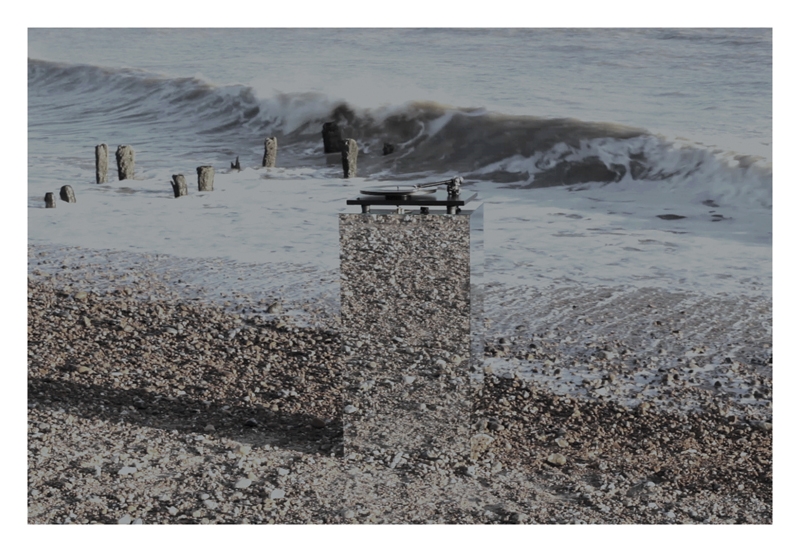‘In every enumeration there are two contradictory temptations. The first is to list everything, the second is to forget something. The first would like to close off the question once and for all, the second to leave it open.’
Georges Perec, ‘The ineffable joys of enumeration’, from Think/Classify, 1985
A turntable on a mirrored plinth on a beach.
The tide coming in to flood its base.
A bed.
Two views of the same room.
A head.
Two views of the same feet.
A wall.
A man ‘playing’ a record using his finger as a stylus.
The shade of an anglepoise lamp seeming to follow the motion
of another record as it spins.
The record slowly unravelling like a piece of string or tape.
A man’s head tick-tocking from side to side as if he were
a human metronome.
Strips of vinyl from the record covering a man’s head
like the curving patterns generated by a spirograph.
A radiator.
A kettle.
The string of vinyl going through the man’s head: ear to ear.
Sprockets, bolts, cogs and spirals.
A shelf.
A head encrusted by clockwork, like so many barnacles.
The list here is of scenes from a two-channel audiovisual installation by the Japanese-born, London-based artist Hiraki Sawa titled Lineament (2012). The list is partial in the sense of being a selection of scenes remembered from a work that lasts 18 minutes and 45 seconds. In a way this ‘forgetting’ is appropriate given the fact that Lineament is a continuation of a project titled Figment and begun in 2009, responding to one of the artist’s close friends (a music lover) having had a sudden amnesiac episode in which he forgot everything about his past life (including his love of music). In the video a male protagonist awakes in a room and explores an apartment in which various objects – clocks and records – unravel or come apart, while the protagonist appears to try and work out what they are and how they connect into a whole. Rather like the experience of viewing the work. Rather like the experience of assembling a videowork – frame by frame – as well.
Once you start listing the imagery or, perhaps more accurately, groping for the points of reference in an animation by Sawa, it’s easy to make the world he depicts seem odd. But perhaps that’s not because of the oddness or surreal quality of the imagery in his animations, but rather because his animations, in which objects play a key role (early works such as Dwelling, 2002, and Migration, 2003, featured miniature aeroplanes and airports located in domestic settings), resist objective description. In part because by its very nature (a sequential series of images) a videowork cries out for subjective interpretation, or at least to be turned into some sort of story by the viewer. Although in Hollywood-type movies, of course, that would be the job of the director and scriptwriter. Perhaps this impulse is something Sawa attempts to defy.
In both Lineament and Envelope (2014, recently shown together with Lineament at James Cohan Gallery, Shanghai), the artist plays with linear and nonlinear time, via bodies repeating actions, bodies and objects being doubled, the use of mirrors (in the case of the single-channel Envelope, mirrors are installed to reflect the video projection) and Eadweard Muybridge-style motion-capture. It’s even harder to make a list when things repeat themselves.
As a viewer of a work by Sawa, you’re conscious of being pushed into constructing or assembling something – in Lineament a story of amnesia (in itself almost a contradiction in terms) – just as the protagonist in the video seems to be doing to the world around him. And that’s not least because while there are images of records playing in the video, when the work is shown in a gallery there is also a record (playing a palindromic soundtrack – it plays one way, then the other – by Dale Berning and Ute Kanngiesser) playing in the room with you.
Perhaps all this comes to the fore because in this work the protagonist, due to his lack of memory, navigates a world in which objects seem to be just that and nothing more. While we, as viewers eager to consume and interpret the artwork, pile into it with an innate subjectivity, thrusting meaning into and feeling resonance in every single frame. And there’s a good and bad side to this.
There is something at once uplifting and terrifying about the idea that nothing in the world is so unique that it cannot be entered on a list. (Perec)
To some degree the images that follow this page came out of a discussion of sorts with the artist about how one might represent a moving-image work within the pages of a magazine, how one might attempt to make a whole of something that, because of the nature of the printed page, can only be represented as a series of parts. What follows is a ‘list’ assembled by the artist.
Hiraki Sawa: Man in Camera is on view at Parafin, London, through 17 September 2016.
This article was first published in the Autumn 2015 issue of ArtReview Asia.
